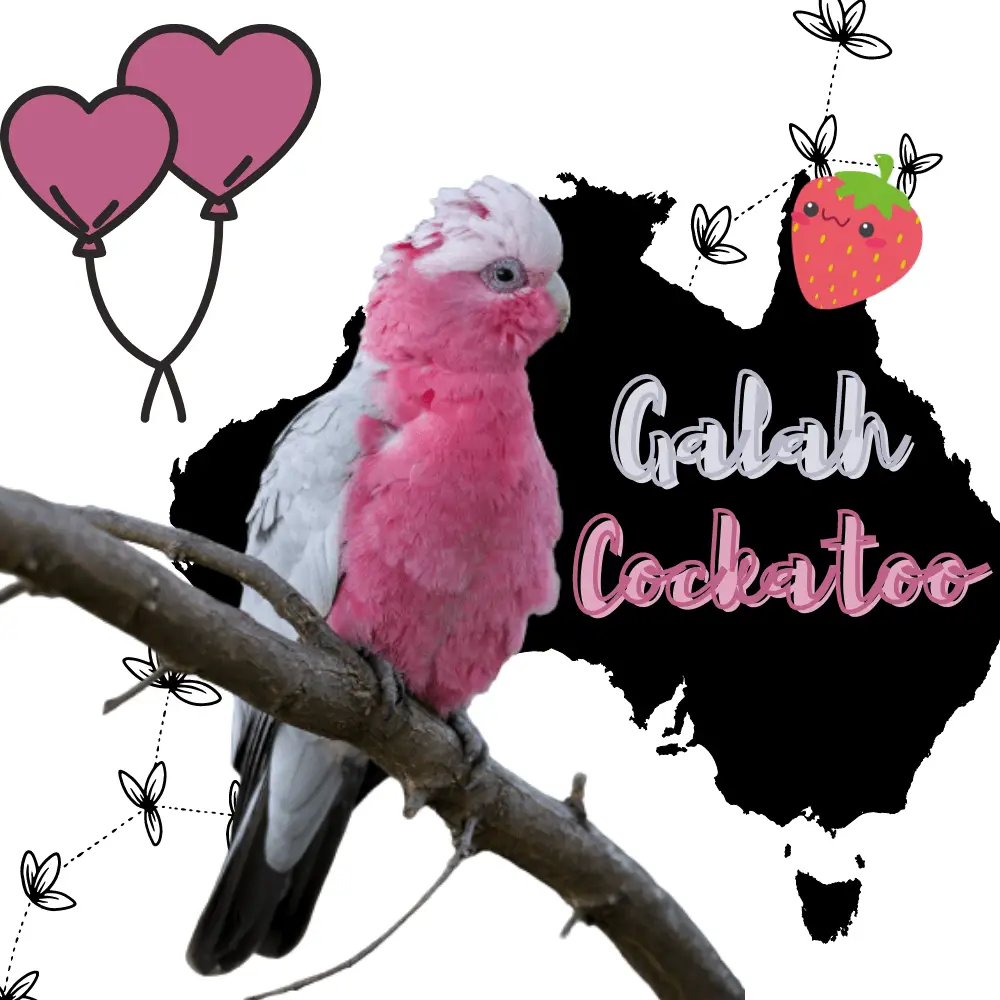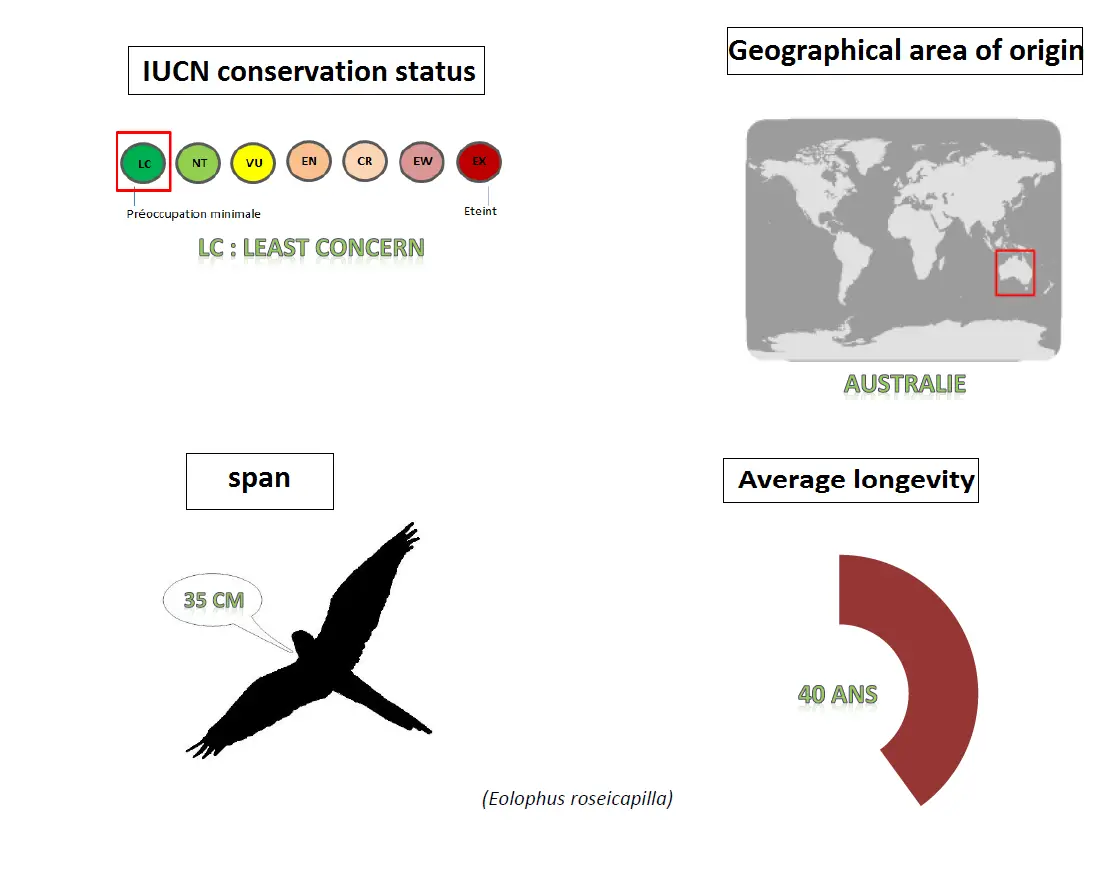
Order: Psittaciformes Famille: Psittacidae
Régime juridique: CITES Appendix II, free quota holding
Sex: Slight sexual dimorphism
Cacatoes family
Origin: Australia
Size: 35 cm
Legal status: Annex 2 Cites
Weight: 270 – 350g
Phenotype:
- Parrot on a gray back and pink sale with a pink-white erectile crest
- The color of the iris makes it possible to determine the sex: black in the male, brown to red in the female
Character: Cf.cockatoo crested yellow
The Rosalbin Cockatoo (Eolophus roseicapilla) is a species of bird in the family Cacatuidae. It is one of the most common cockatoos in Australia. It is the only species of the genus Eolophus.
The Galah Cockatoo are real clowns, easy-going, very affectionate (like all cockatoos), but also full of energy. They are probably the most extroverted of the cockatoo group. Discover their personality and their requirements …
Galah Cockatoo Personality

Particularly players, curious about everything, they make wonderful pet birds and are easy to educate. A real treat with a sparkling personality.
The Galah Cockatoo is a very social, intelligent, and playful bird requiring stimulation and frequent interactions: games, training in turns, verbal exchanges.
They have great self-confidence and if not cared for, they can have unpredictable reactions. It is therefore essential to educate them well by respecting very clear rules.
The Galah Cockatoo birds These birds are generally not noisy (unlike other members of their family) except in the morning and in the evening and during their little moment of madness.
Their voice is particularly pleasant and expressive. On the other hand, their cry is piercing, fortunately, rarely used. It is a bird that can easily be kept in an apartment.
The Galah Cockatoo has a real ability to speak, can imitate the human voice, and develop a vocabulary with a small high-pitched voice. Quite quickly, they will imitate many sounds. Some of them are even real pipettes.
Galah cockatoo Behavior
The crested cockatoo is common in most of its habitat. Outside the breeding season, these noisy birds congregate in large groups to feed on meadows, bushes, and trees. They feed on seeds, fruits, hearts of palm trees, and insects. They can hold their food with the fingers of one leg, while with the other they break or tear off pieces.
They are sometimes seen as pests for crops, and farmers kill or poison them. While the group feeds on the ground, several birds remain perched in the neighboring trees and watch the surroundings to alert the group in case of danger. If a predator or an intruder approaches, they give their raucous and loud cries.
They sleep in a common dormitory where you can find several hundred birds. They return there every evening at dusk.
During the breeding season, the crested cockatoo is often seen in pairs or small family groups. At midday, they shelter in the shade of the nearby trees with which they damage the leaves and bark, enough for the loss of foliage to destroy the tree.
Southern birds tend to feed on the ground, while northern birds are more arboreal. They become common around human habitations where they are parasites that use their powerful beak to destroy panels or other parts of houses.
The courtship display is simple. The male struts along a branch of a tree towards the female. He erects his crest, and swings his head up and down and from side to side, forming an “8”. At this time, it emits a soft chatter and the two partners practice the mutual smoothing of the feathers and the “beak to beak”.
Description
It measures 35 to 36 cm long and weighs 300 to 400 g. It has a pale or medium gray back and wings, a pink face and chest, and a pinkish-white hoopoe.
The bill is clear and the legs pinkish gray. The sexes are similar and differ only in the color of the iris: brown or reddish in the female and black or dark brown in the male. Immatures are similar to adults but have light brown irises.
The Rosalbin has a lifespan of more than 60 years in captivity while in freedom it generally does not exceed 20 years. It is granivorous and frugivorous.
They generally form groups of 30 to 100 individuals, however, they can manage to form flocks of more than 1000 birds often mixed with other species of cockatoo (naked eye cockatoo, cockatoo crested, cockatoo Leadbeater), especially during their feeding. they move in smaller groups in wooded areas at the end of the day to sleep1
Habitat
It occupies all the unforested parts of the Australian continent. It avoids extremely desert areas and very dense forests. It has also been introduced to the Tasmania region.
It lives in forests, semi-arid areas, pastures, areas inhabited by humans such as parks and gardens, wooded areas, farms for livestock, and cropland.
They are sedentary birds that rarely move more than 10 km from the nesting area and it is not common to observe them at heights above 1250 meters above sea level.

Subspecies
According to the reference classification (version 5.2, 2015) of the International Ornithological Congress, this species is made up of the following three subspecies (phylogenic order):
Eolophus roseicapilla albiceps Schodde, 1989 with whitish eye circles populating Tasmania;
Eolophus roseicapilla kuhli (Mathews, 1912) with reddish-gray eye circles;
Eolophus roseicapilla roseicapilla (Vieillot, 1817) with pink eye circles.
Reproduction
The Rosalbin reaches sexual maturity around 2/3 years.
Occasionally they have been seen nesting in rock cavities, cliffs, and holes in artificial concrete walls, but they prefer large eucalyptus trees varying in height from 3 to 20 meters.
The female lays 3 or 4 eggs, sometimes 5 or 6. The incubation lasts 23 to 30 days, the two parents take turns incubating and providing assistance to the chicks.
The young live in the nest for about seven to eight weeks but return in the evening before being completely independent. Parents feed their offspring every 3 hours2.
Reproduction of the species
The breeding season takes place from August to January in the south, and from May to September in the north.
The Crested Cockatoo nests in tree holes, especially in large Eucalyptus trees, and usually near water. Both sexes prepare the nest. They are monogamous.
The female lays 1 to 3 white eggs. The incubation lasts about 30 days, shared by the two adults. The chicks are nestlings and are fed by their parents. They abandon the nest after 60 to 70 days. They stay with their parents all year round. Family groups can stay united for a long time.
Galah Cockatoo Care
The Galah Cockatoo absolutely needs to work out, and it is essential to let them fly as much as possible. The cage, especially for these birds, is only a refuge for feeding, playing, resting, and sleeping. It’s less about having a gigantic cage than leaving the door open for them to exercise.
Like all cockatoos, they love to chew anything that passes within reach of their beak (though less than other members of the family). It is therefore imperative to distribute toys, branches, pine cones, etc. to them. It keeps their beak in good condition, and it’s an excellent occupation.
The Galah Cockatoo cocoa 2The Galah Cockatoo is considered to be dependent species. Much less than other family members, but more than an Eclectus for example.
They are dependent in the sense that they need frequent social interactions that can be satisfied by handling the bird, playing, training it, explaining new behaviors, maintaining eye contact, recognizing its good deeds, encouraging him, and congratulating him. Rose Breasted Cockatoo are birds that are extremely affectionate, requiring a lot of care and love.
SOURCE:Happy Tails
Galah Cockatoo As Pets
This bird, well known for its beauty and gentle character, is an excellent pet. It does not support solitude, it is a resistant bird that adapts well to different atmospheres in captivity and does not exhibit aggressive behavior.
They spend most of their time on the ground during their feeding and it is also here that the main social interactions take place.
He needs a large cage and lots of peeling objects (fresh branches) because, like all cockatoos, he likes to snack on everything.
Various mutations are known: cinnamon, blue, ivory, pink with black eyes, silver, variegated and white cream with black eyes. It is predisposed to obesity when it is kept in small facilities or develops reproductive disorders.
Galah Cockatoo Diet
The Galah Cockatoo has a strong tendency to obesity and special care must be taken not to distribute excessively fatty food to them.
A mixture for large parakeets (and not for parrots) is suitable as long as there is no sunflower seed. You can distribute pieces of millet branches in the ration. The Rose Breasted Cockatoo loves it and it keeps them busy.
Fruit and vegetables, on the other hand, have not been very successful with The Galah Cockatoo. Let’s be clear, they don’t eat it or hardly eat it. We can always try to give them carrots, which they like to shred, and in very small doses, corn, chickpeas. Apples and pears are generally refused.
Granules remain the best way to balance the diet, especially for The Galah Cockatoo who eats little fruit and vegetables. Granules supplemented with fruits and vegetables are our preference. They accept them perfectly.
In the wild
The Rosalbin feeds on a varied diet in freedom, it feeds on seeds, cereals (especially oats, wheat, barley), fruits, berries, roots, stems, insects, and larvae which vary according to the seasons. It feeds in groups and on the ground early in the morning and in the evening.
In captivity
The Rosalbin feeds on a mixture of seeds made up of dried fruits, sunflowers, and cereals, it also feeds on a lot of fresh fruits and vegetables.
During the breeding season, the breeder can provide an insect-based animal feed to help feed the offspring
Galah Cockatoo For Adoption
The Rose Breasted Cockatoo is a wonderful pet bird, easy to live with, not very noisy, and very robust. A real concentration of affection and energy, perfectly suited for a family with children, which can be kept in an apartment.
And the last point, it is a bird of great beauty, with a very beautiful pink color. You will understand, we have a big weakness for this clown at
What Life Is Like With a Galah Cockatoo
SOURCE: MARLENE MC’COHEN
Galah Cockatoo Lifespan
Its life expectancy once was around 15-18 years, probably due to popular ignorance of poor diet of your needs. Hoy en día dressed in animals of hasta 40 years of life.
Galah Cockatoo Price
the price of a galah cockatoo is 1000$




















